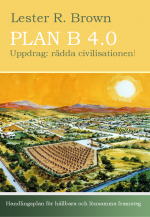Wednesday, September 03, 2014
Summer months are usually a time to recharge and relax, but the EPI staff has not taken a break from spreading the message of Plan B and sustainability. Over the summer, Lester Brown and our researchers spoke to a variety of groups on topics including food, climate security, and renewable energy.
On June 22, Emily Adams kicked off the Washington Youth Summit on the Environment with a discussion on food and our global environment. This group of 250 high school students from across the United States and as ked lots of informed questions, ranging from what they can do to help the food situation to global policies on population growth. A Summit intern live-tweeted the event. (By the way, the intern had attended Emily’s 2013 Summit presentation and plans to pursue environmental policy when she starts her college career.)
ked lots of informed questions, ranging from what they can do to help the food situation to global policies on population growth. A Summit intern live-tweeted the event. (By the way, the intern had attended Emily’s 2013 Summit presentation and plans to pursue environmental policy when she starts her college career.)
Later that week, Emily spoke to the Global Young Leaders Conference in Arlington, Virginia where she was peppered with more thoughtful questions from high school students, this time from across the globe. The international audience provided the bonus of hearing a diverse set of perspectives on global environmental issues. The next generation of environmental leaders is ready to make Plan B a reality!
On June 27, Janet Larsen spoke at the Climate Security Roundtable at the American Legion in Washington D.C. Rod Clifton, the American Legion member who organized the event had been influenced by EPI’s research, particularly Plan B, in his post’s efforts to mobilize to “support local renewable energy alternatives and green jobs in support of our U.S. Armed Forces, U.S. Veterans, and our Nation.” He is developing “Carbon War Bonds” and sent the fourth issued draft bond to Lester Brown.
A goal that emerged from the meeting is to further engage with other posts of the American Legion and the Veterans of Foreign Wars on the issue of climate change as a major threat to national security. The number of statements from high ranking military and intelligence leaders taking the climate change threat seriously provides ammunition for a rapid mobilization like EPI calls for in Plan B.
In late July, Matt Roney spoke at the third annual Earth 2100 Conference at George Mason University in Fairfax, Virginia. His talk on transitioning the global economy from fossil fuels to renewable energy highlighted in particular the fast-growing contributions of wind and solar power worldwide. Organized by Our Task—a non-profit group dedicated to helping young adults become leaders in creating a more sustainable world—the two-day event featured speakers and representatives from many other organizations as well, including: Climate Progress, U.S. Environmental Protection Agency, Sierra Club, Chesapeake Climate Action Network, Center for a New American Dream, Population Institute, United Nations Framework Convention on Climate Change, and Worldwatch Institute. More information, including video of the talks and panel discussions, is available here.
 And topping off this busy summer, Lester spoke at the annual ARE Day Summit in Aspen, Colorado in early August. This year’s Summit was titled “Accelerating Solutions for the Great Transition.” The mission was to promote the rapid deployment of renewable energy and energy efficient strategies. Speakers and attendees included Ted Turner, T. Boone Pickens, Colorado Senator Michael Bennet, actress Daryl Hannah, and Dr. Sylvia Earle of Mission Blue. Lester spoke on transitioning from fossil fuels to renewable energy, the focus of his forthcoming book, The Great Transition: Shifting from Fossil Fuels to Solar and Wind Power.
And topping off this busy summer, Lester spoke at the annual ARE Day Summit in Aspen, Colorado in early August. This year’s Summit was titled “Accelerating Solutions for the Great Transition.” The mission was to promote the rapid deployment of renewable energy and energy efficient strategies. Speakers and attendees included Ted Turner, T. Boone Pickens, Colorado Senator Michael Bennet, actress Daryl Hannah, and Dr. Sylvia Earle of Mission Blue. Lester spoke on transitioning from fossil fuels to renewable energy, the focus of his forthcoming book, The Great Transition: Shifting from Fossil Fuels to Solar and Wind Power.
For upcoming speaking engagements, check out our Events page. See Lester Brown at the New York Society for Ethical Culture on September 20 when he takes part in A Global Climate Treaty: Why the United States Must Lead.
Best,
Julianne Simpson
Tuesday, August 12, 2014
"By the time Carl and I started growing tomatoes, they were one of New Jersey’s most popular and most highly valued products. South Jersey supplied fresh tomatoes each summer to Philadelphia and New York. In addition to canning them, the industry turned them into tomato juice, tomato soup, and ketchup. With two tomato processors in Bridgeton, P.J. Ritter and Pritchard’s, the summer air was filled with the mouth-watering aroma of ketchup being cooked in huge vats laden with spices. This aroma was an integral part of every summer of my youth.
Of all the crops that we could grow, Carl and I chose tomatoes. Why? For one thing, the growing season of the tomato meshed well with the academic year. That is not to say there was no overlap, because the tomato fields had to be planted in April or, at the latest, early May—well before school was out. At the other end of the season, when school started in the fall, there were still tomatoes in the field. This too was scramble time for us. 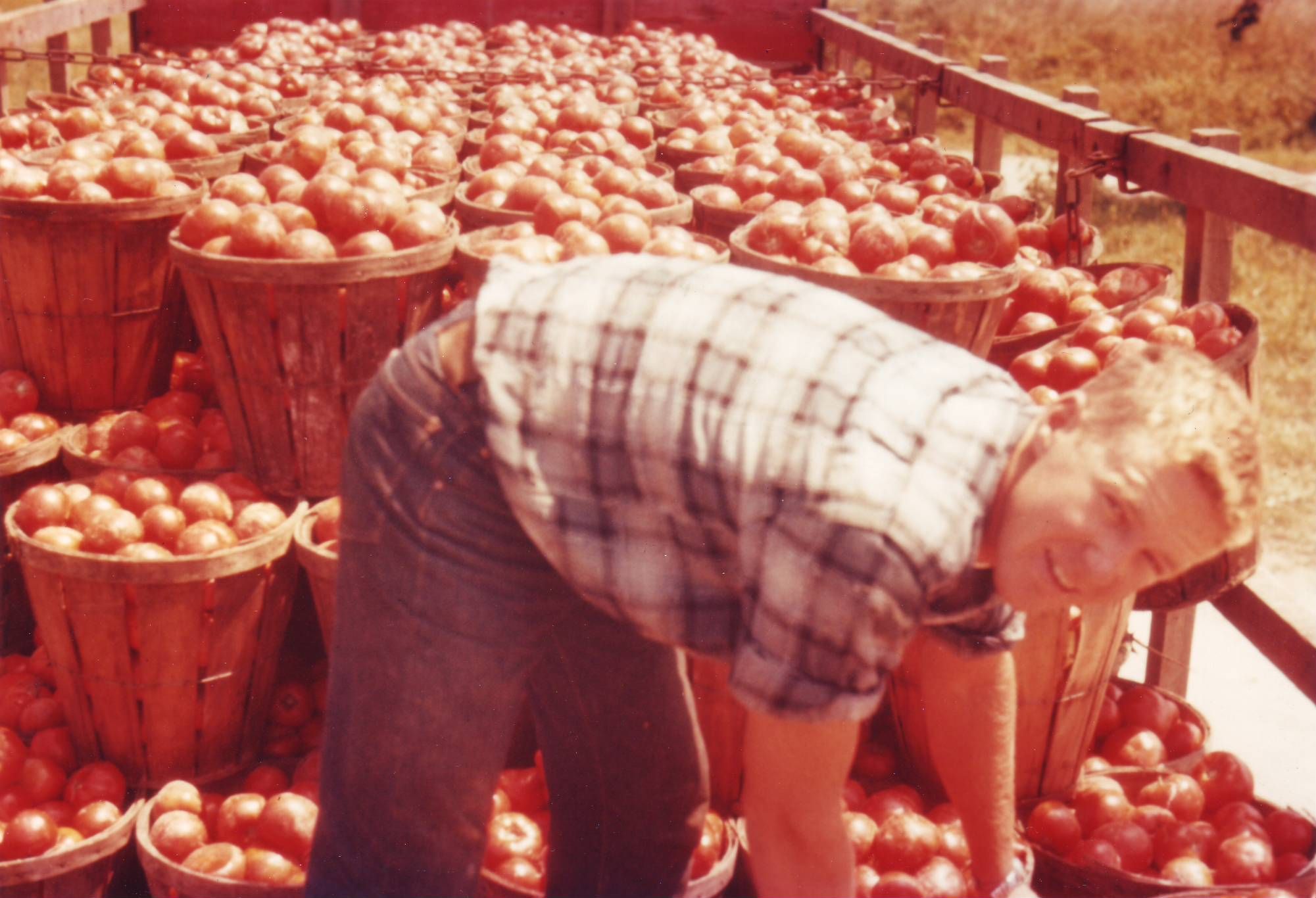
At the same time, tomatoes are fun to grow. They are so responsive and productive. Displaying its fruit—some ripe, some ripening, and some still green—a tomato plant is a work of art. And I like the distinctive aroma of a tomato plant. To this day when I see a tomato plant I cannot resist smelling it.
One of the challenges for us was how to finance our ever-expanding tomato operation. My brother and I had an understanding with Pop. As long as we did our chores and got everything done and done well, Pop did not care what we did with the rest of our time. So in the spring, for example, my brother assumed the responsibility of milking not only the cows he was responsible for, but also mine. I, meanwhile, would run a mile and a half to a local farm to spend a couple of hours before school helping the farmer cut his four acres of asparagus. He paid $1 an hour, enabling us to accumulate some cash. It also provided some training, since I was running the mile on the school’s track team.
In addition to picking strawberries and cutting asparagus for other farmers, we would also help at hay baling time using an old truck we had bought to haul hay bales from the field to the haymow. Farmers liked to hire Carl and me because we worked so hard. We also competed with each other. I was the first to pick 100 baskets of tomatoes (thirty-five pounds each) in one day. Then Carl took it to 102. After that, the record went back and forth between us: 105, 107, 108, and then 110. It was no accident that I won the Cumberland County Junior Tomato Picking Championship in 1949! Nor that Carl was selected as a New Jersey Star Farmer by the Future Farmers of America!
In 1949 we bought our first tractor—a J.I. Case two-plow, mid-size tractor of ancient vintage—largely with earnings from picking tomatoes for other farmers. At 10¢ a basket for picking tomatoes, it took 2,000 baskets to pay for the tractor.
In late August 1951, on the weekend before I was to report to Rutgers University for freshman orientation, we faced a logistical problem. While I had a driver’s license, Carl did not. Once I left for Rutgers, Carl would still need to get tomatoes from our farm to the cannery a dozen or so miles away. The problem wasn’t so much the lack of a license, really, because young people on a farm often drove locally before they were licensed. The problem was that Carl had never driven a truck laden with tomatoes stacked five baskets high.
With this in mind, we decided to take a load to the cannery on Saturday, the day before I left. Loading over 200 baskets of tomatoes onto a truck is an art in itself. The body of a tomato truck is designed so the tomato baskets can be 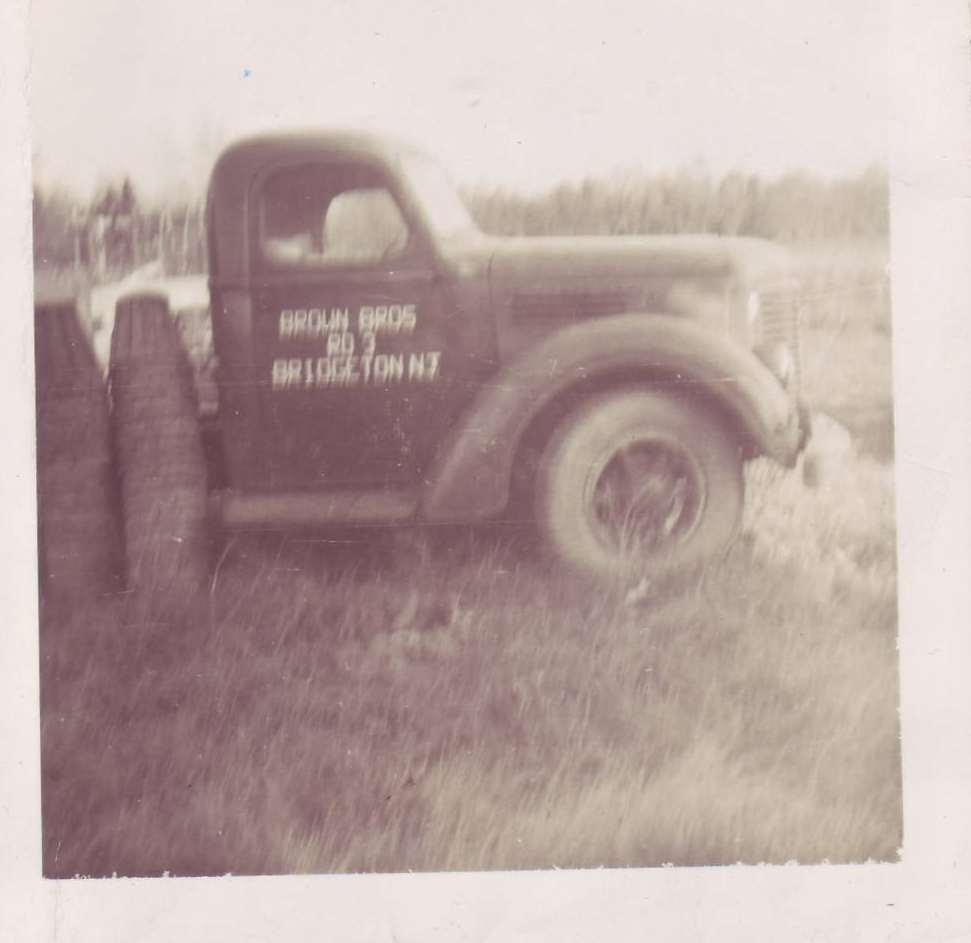 stacked in an extended pyramid, stretching from the front to the back. The sideboards enabled us to put another layer of baskets leaning in against the pyramid on both sides to stabilize it. It was a tried-and-true way of moving tomatoes from the farm to the processing plant. Our aging 1935 Chevrolet truck carried at least four tons of tomatoes.
stacked in an extended pyramid, stretching from the front to the back. The sideboards enabled us to put another layer of baskets leaning in against the pyramid on both sides to stabilize it. It was a tried-and-true way of moving tomatoes from the farm to the processing plant. Our aging 1935 Chevrolet truck carried at least four tons of tomatoes.
We decided that Carl would drive the truck to the cannery and I would follow in the pickup soon after. He would have to get it in line, because there was always a long line of trucks waiting for hours to be unloaded.
The last stretch of road of five miles or so to the cannery was straight. Carl driving the heavily loaded truck came up behind a local farmer who was drawing two or three implements behind his tractor. Carl prepared to pass and was already well onto the left side of the road when he realized the farmer was going to move out into the center of the road to make a right turn into his driveway. The truck’s wheels went over onto the dirt shoulder and the truck began to lean with its heavy load. Carl pulled it back onto the road, but not all the tomatoes made it back with him. Part of the load tumbled off, leaving tomatoes strewn several inches deep across a swath of the road. He pulled over to assess the damage and wait for me.
By the time I arrived, cars had already driven over the road—and through the tomatoes. But as though they were driving through newly fallen snow, the drivers had kept to one lane, carefully using the same ruts to minimize the damage.
Someone suggested we call our field agent at P.J. Ritter. We called from the farmer’s house and the agent arrived quickly. Taking stock of the situation, he saw that most of the tomatoes on the road were still in good condition. Many were bruised and some were cracked, but it was obvious we had picked them carefully and that they were of unusually high quality. He suggested that we borrow a couple of shovels or scoops from the farmer to get as many of the tomatoes back on the truck as we could, preferably without sand or gravel. He said we wouldn’t be able to get all of them, but we could get most of them.
He requested that we then ask the farmer if we could park the truck behind his barn out of public view, since these cracked tomatoes could become a public relations issue for Ritter. And he told us to bring the truck into the plant the next morning at 5:30 a.m., when they would unload it immediately to minimize the chance of the cracked tomatoes spoiling.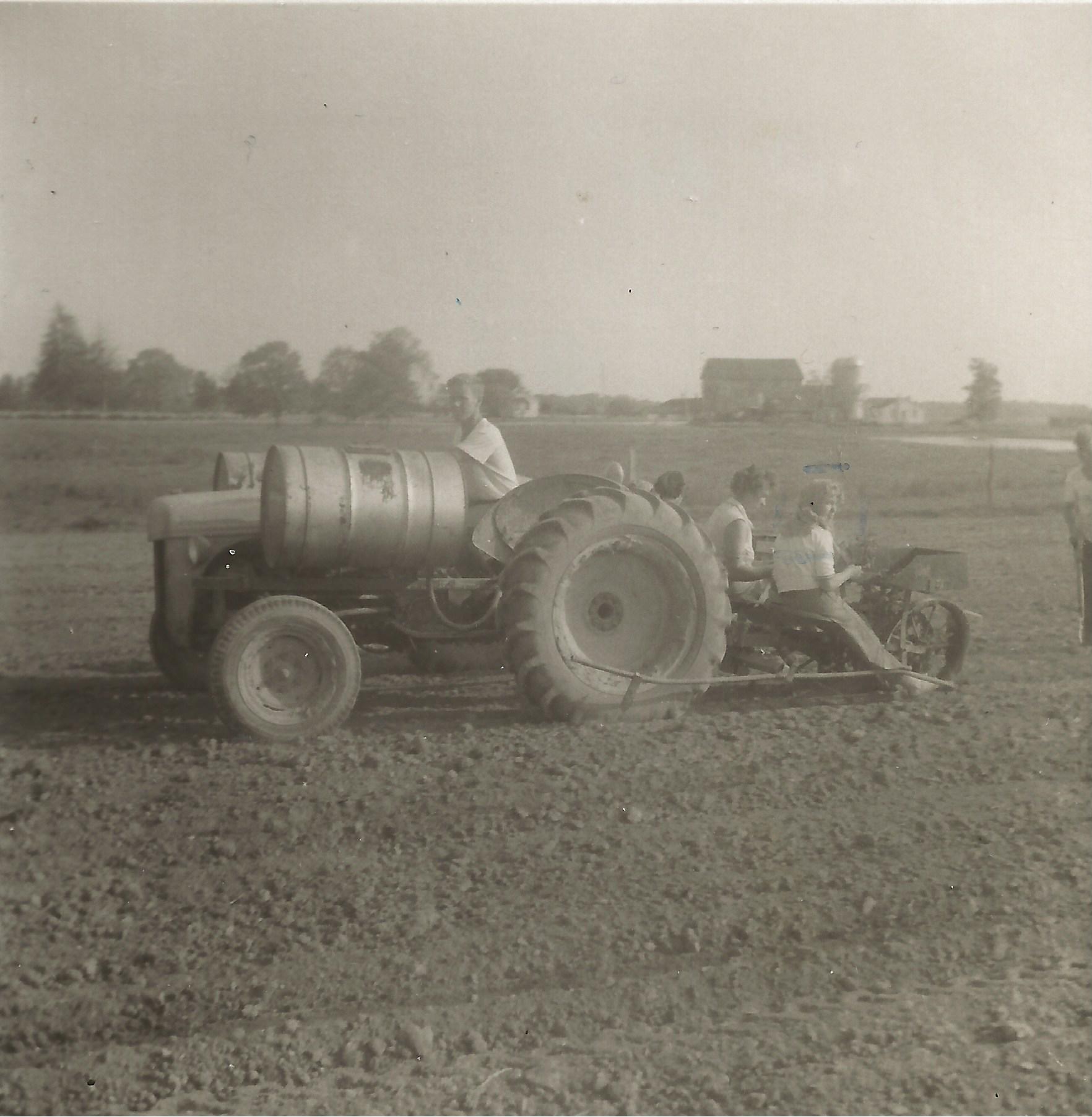
Despite the loss of a small part of this load, we delivered many other loads and did well that year. We were officially tomato farmers. And since we did most of the work ourselves, much of the check that we got in November for all the tomatoes we had delivered put us in a position to buy another tractor—a brand-new one. My brother and I knew exactly what we wanted, a new Ford two-plow tractor. I suggested that he go ahead and buy it. Carl had worked hard and I wanted him to have the experience and satisfaction of buying the tractor.
He went to the local farm equipment dealer, who obviously knew us, but who was not well prepared to sell to a fourteen-year-old. It took him awhile to realize that my brother was serious and that he wanted not only a tractor but also the plow and cultivators to go with it. We bought that tractor in the fall of 1951 for $2,100 with an initial down payment of $700 and with the remainder to be paid in $700 installments in the fall of each of the next two years, a typical arrangement for farmers.
We had started growing tomatoes just when the industry was on the verge of rapid change. After a couple of years of planting by hand, we got a mechanical transplanter. The transplanter, on which four people could ride, planting two rows of tomatoes at a time, was drawn behind the tractor. Mounted on each side of the tractor hood were two drums filled with water that contained a liquid fertilizer. Thus, as each plant was going into the ground, roughly half a cup of water would be released at the same time to provide moisture around the roots of the plant as well as the essential nutrients: nitrogen, phosphate, and potassium. This helped to get plants off to a faster start than with traditional hand-planting.
As our tomato-growing operation grew, we shifted from the local tomato processor, P.J. Ritter, to Campbell Soup, which could readily handle our larger harvests. It is hard to believe today that we were producing and delivering tomatoes to the Campbell Soup plant in Camden, New Jersey, for $34 a ton.
During our first year of tomato growing with only seven acres, Carl and I picked nearly all the tomatoes ourselves. But as I expanded the acreage, eventually to seventy acres (280,000 plants) in 1958, we needed a lot of help with the picking. Our pickers included classmates, friends, and, as we grew larger, seasonal workers from nearby Salem and even some from Puerto Rico via a contract with the Puerto Rico Department of Labor.
In 1958, I ma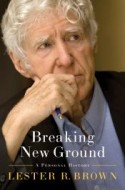 rketed 1.5 million pounds of tomatoes, becoming one of the largest tomato growers in New Jersey.
rketed 1.5 million pounds of tomatoes, becoming one of the largest tomato growers in New Jersey.
The eight-year tomato-growing period of my life, 1951 through 1958, began during my senior year in high school, spanned the four years at Rutgers, the months I lived in villages in India in 1956, and two years beyond that. I had developed an attachment to the land. Even now whenever I return to Stow Creek for family visits, driving through the countryside with its fertile, sandy loam fields, patches of woodland, and creeks, I enjoy a sense of peacefulness and of being grounded."
To read more of Lester Brown's experiences growing tomatoes as well as other parts of his life, purchase a copy of Breaking New Ground today for our special sale price of $15.00.
Best,
Reah Janise Kauffman
Tuesday, August 05, 2014
At its annual conference, WorldFuture 2014: What If, in mid-July, the World Future Society honored Lester Brown with its 2014 award “for distinguished service in promoting the vital work of futurists.” See his acceptance speech here.
Lester’s involvement dates to before the founding of the World Future Society (WFS) when he and Edward (Ed) Cornish and their families attended the Cedar Lane Unitarian Church in Bethesda, Maryland.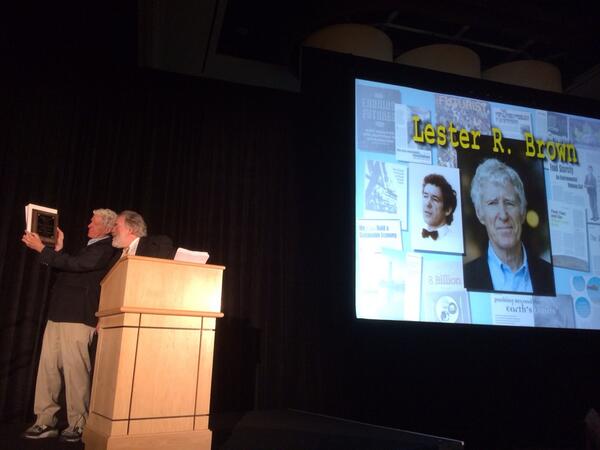
Ed Cornish established the WFS in 1966 as a nonprofit educational and scientific organization in Washington, D.C. It has members in more than 80 countries around the world.
As noted on its website, the WFS “investigates how social, economic and technological developments are shaping the future. It helps individuals, organizations, and communities observe, understand and respond to social change appropriately and investigates the benign effects of applying anticipatory thinking to society.
“Through its magazine The Futurist, media, meetings, and dialogue among its members, it raises awareness of change and encourages development of creative solutions. The Society takes no official position on what the future may or should be like. Instead it provides a neutral forum for exploring possible, probable, and preferable futures.”
Lester often spoke at their conferences and published articles in WFS’s magazine, The Futurist. His first piece, which appeared in the August 1969 issue, was entitled “The Optimistic Outlook for World Food Production.” His most recent article, “Food, Fuel, and the Global Land Grab,” was in the January-February 2013 issue.
When Lester laun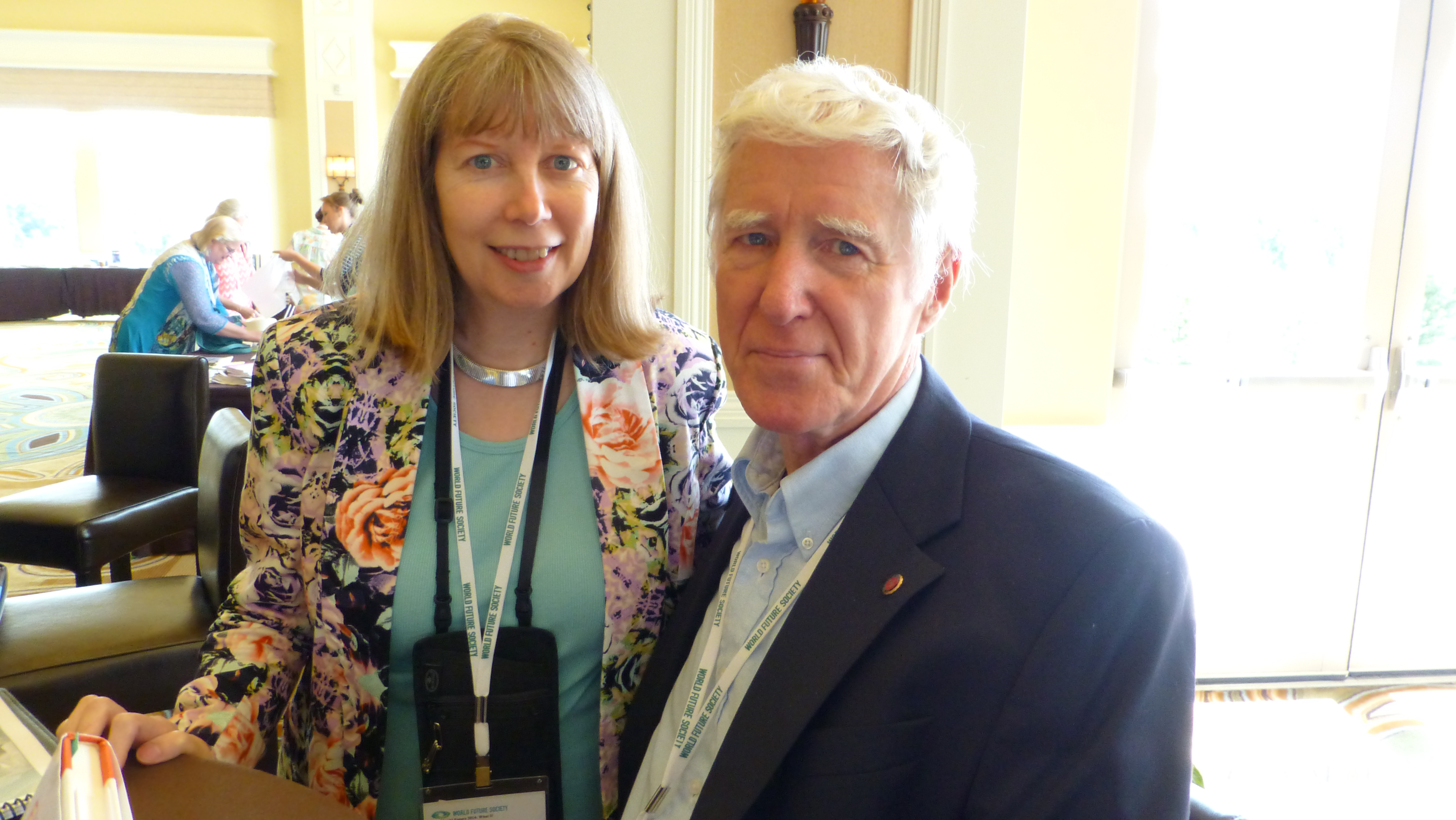
“When I started working at the World Future Society, one of the first authors I worked with was Lester Brown,” says Futurist editor Cindy Wagner (left). “He wrote urgently and eloquently in The Futurist about the need to make more sustainable choices in our lifestyles. I took what Brown wrote to heart when I decided to move to an apartment building that was within walking distance of the office.”
At the conference, Lester also delivered a presentation on “The Great Transition: Shifting from Fossil Fuels to Wind and Solar” after which he signed copies of his memoir, Breaking New Ground.
Cheers,
Reah Janise Kauffman
Wednesday, July 09, 2014
At the 80th birthday celebration, two of the “speakers” had worked with Lester when he had headed the International Agricultural Development Service at the U.S. Department of Agriculture (USDA). At the going away party for Lester in 1969, two of his colleagues, Bill Jones and Mac Destler, sang a song, which they reprised for this happy evening.
The following is an excerpt from Breaking New Ground: A Personal History that describes this time in Lester’s life.
"One of the hallmarks of the USDA during the Kennedy-Johnson era, the eight-year span when Orville Freeman was secretary of agriculture, was the department’s growing involvement in international agricultural development. In 1964 the USDA, working with the AID, had created a new agency—the International Agricultural Development Service (IADS). Matthew Drosdoff, an agronomist who had been the Food and Agricultural Officer for the AID in Vietnam since 1962, became the first agency head. In contrast to the Foreign Agricultural Service, whose responsibility was to develop markets for U.S. farm products, the purpose of the IADS was to help develop agriculture in third-world countries. In many countries the AID subcontracted the agricultural part of their program to the IADS.
In 1966, it was decided that the agency should be playing more of a policy role, and Secretary Freeman appointed me the IADS administrator. I had no idea this was coming, but I was both pleased and honored.
Two years earlier the agency had been cobbled together very quickly, with personnel donated from other agencies in the USDA. Unfortunately, this meant that the various agencies often sent employees who were about to retire and not their most productive. To help make it a more effective agency, I hired some talented young staffers from outside the department, including I. M. Destler (who got his masters in public administration from Princeton), William Abbott (a White House fellow who had edited the Harvard Law Review), and William Jones, editor of Development Digest. From within the department, I hired Lyle Schertz and Dana Dalrymple.
As the youngest agency head in government, I needed to learn a lot quickly. To help me, I recruited the experienced Mollie Iler from the embassy in Rome, the one who had typed each draft of our agreement with India, as my administrative assistant.
We had a huge range of on-the-ground projects going in thirty-nine countries, including expanding rice production in Senegal, breeding higher-yielding corn varieties in Kenya, organizing farm co-ops in Brazil, and helping the Maasai in Tanzania improve their herd management. Managing the IADS was complicated, simply because we were working with the AID, the host-country government, and officials and farmers within the country.
I headed the IADS for two years, then in 1968 Richard Nixon was elected president. I knew that I did not want to work in a Nixon administration. I resigned, leaving office a week before Nixon was inaugurated in January 1969. Much to my regret, Nixon dismantled the IADS. The reason given was that U.S. farmers did not want the USDA helping other countries to develop their agriculture, thus creating competition for them."
Stay tuned!
Reah Janise Kauffman
P.S. Our thanks to Moser Media for the great video work!
Wednesday, June 18, 2014
You are invited to a post-attendance of Lester Brown’s 80th birthday celebration. Over the next few blog postings, we are going to share some of the memories and comments people at the party gave.
Today’s release, however, is not from the formal event. Lester has not just been a researcher on global environmental issues over the course of his life. He has been a tomato farmer, a college student, headed a division of the U.S. Department of Agriculture, and founded two think tanks. He has worked with the media and he has published over 50 books in over 40 languages.
We invited our national and international publishers to the celebration. Alas, only a few were able to attend. But we wanted to honor these individuals for their commitment over the years, and sometimes decades. So we held a lunch in their honor and asked them to share their stories.
We’d like to share some of them with you.
Gilberto Rincon of CEID, a Colombian research institute, has been publishing the Spanish edition of our books for eight years.
Kiril Ivanov, founder and head of Paper Tiger, a publishing house in Bulgaria, has been publishing since the 1990s.
Wei Lin represented his father Lin Zixin, who began publishing books by Lester in the 1980s when he worked with the International Scientific and Technical Information Center. Since his retirement, he has secured publishing houses and headed the translation team for Lester’s books published in this century.
Amy Cherry representing W.W. Norton and Company, our U.S. publisher, noted that they had been publishing books by Lester and his organizations for forty years.
Some of our publishers who could not attend, posted messages in the birthday guestbook on our website. Please check them out … and possibly add your OWN sharing of how Lester’s work has influenced you.
Cheers,
Reah Janise Kauffman
P.S. Our thanks to Michael Moser of Moser Media for his great video work!
Tuesday, May 27, 2014

Lester Brown’s 80th birthday celebration has come and gone, but we are all still talking about it—and likely will be for some time.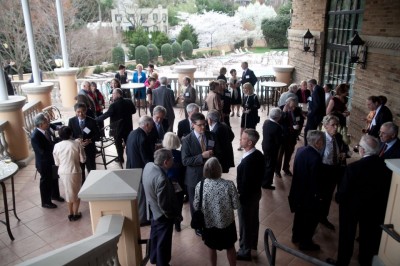
Celebrants included Lester’s family, long-time friends, fellow International Farm Youth Exchangees (1956), Saturday afternoon football teammates, colleagues from the U.S. Department of Agriculture and Worldwatch, folks from Rutgers, publishers, donors, funders, film producers, heads of NGOs, columnists and media, business acquaintances, Earth Policy Institute board members, colleagues, and former staff members, and more.
The event was held at the Omni Shoreham Hotel in Washington, DC—and the cherry blossoms were in full regalia!
Here are some glimpse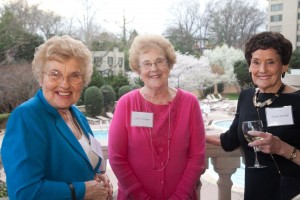 s. In order of appearance (1) Marilyn Moreland, Gloria Ward Woehler, and Angela Kendall (International Farm Youth Exchangees), (2) Mohamed El-Ashry and Finnish Ambassador Ritva Koukku-Ronde, (3) Cash Haun (grandson) and Nathanael Brown (grandnephew), (4) Hal Kane, Nick Lenssen, Alan Durning, and Michael Renner (former Worldwatchers), (5) Ted Turner, (6) Bulgarian publisher Cyril Ivanov, and (7) Tom Weis of Climate Crisis Solutions speaking at the open mic.
s. In order of appearance (1) Marilyn Moreland, Gloria Ward Woehler, and Angela Kendall (International Farm Youth Exchangees), (2) Mohamed El-Ashry and Finnish Ambassador Ritva Koukku-Ronde, (3) Cash Haun (grandson) and Nathanael Brown (grandnephew), (4) Hal Kane, Nick Lenssen, Alan Durning, and Michael Renner (former Worldwatchers), (5) Ted Turner, (6) Bulgarian publisher Cyril Ivanov, and (7) Tom Weis of Climate Crisis Solutions speaking at the open mic.
We’ll be sharing some of the video clips from some of our distinguished and interesting speakers in an upcoming post.
Cheers,
Reah Janise Kauffman
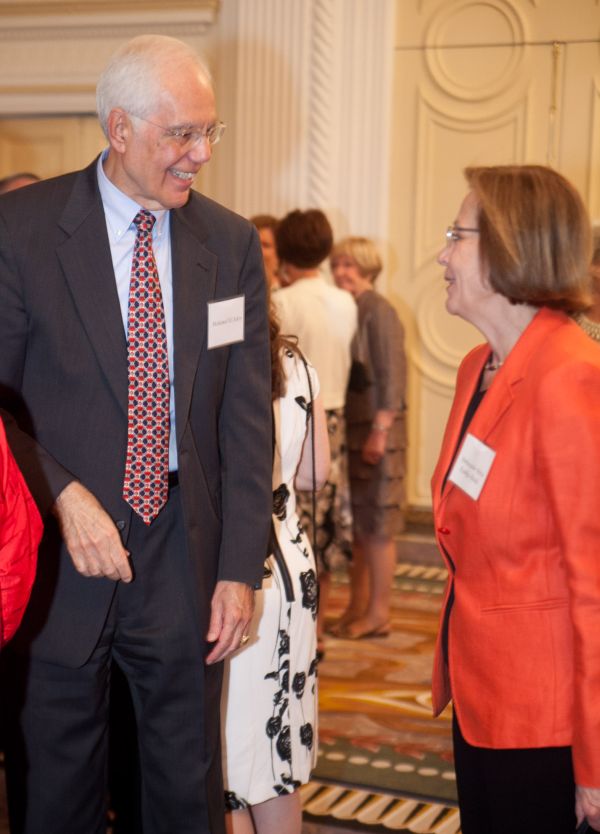 |
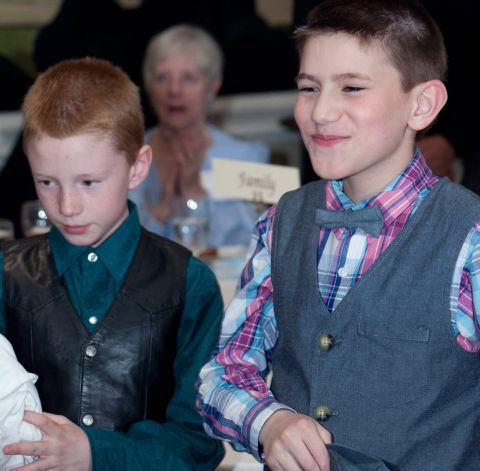 |
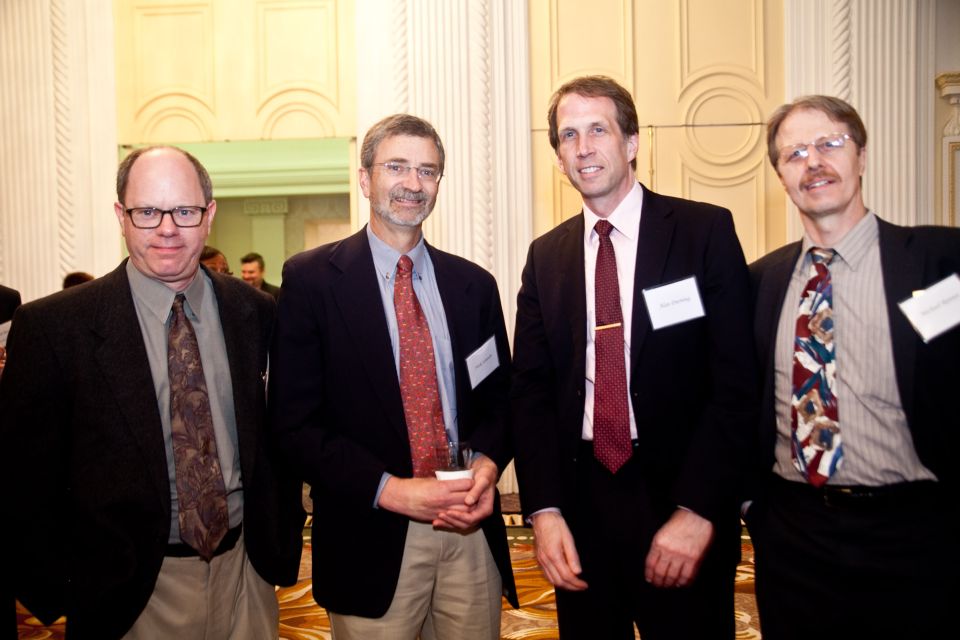 |
 |
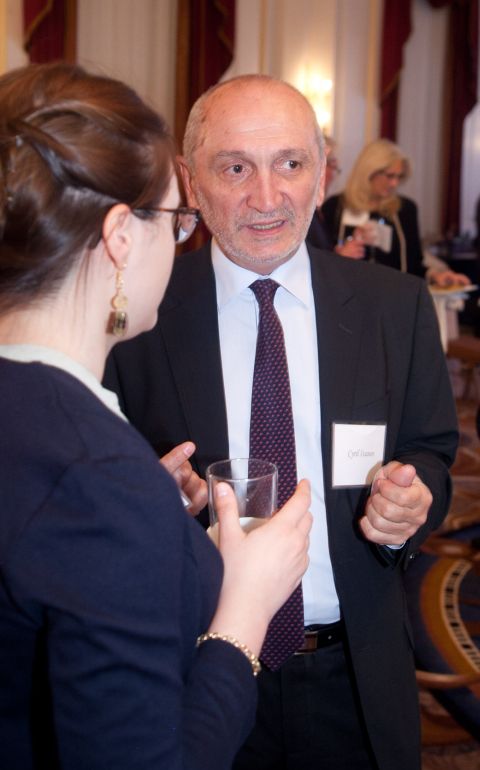 |
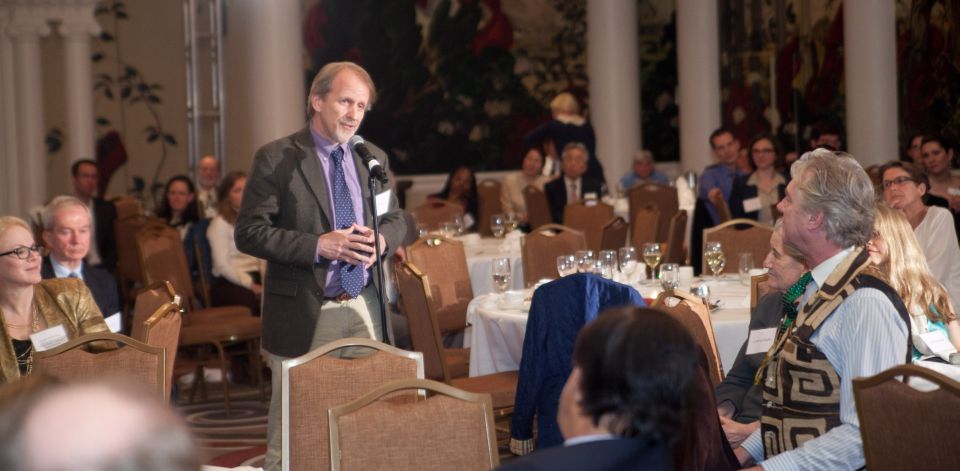 |
Friday, April 04, 2014
Lester Brown, EPI’s intrepid president, has just completed 80 cycles around the sun. As part of our celebration, we’re inviting you to add your comments or stories you might have about Lester, how his writings may have influenced you, to a special birthday blog we have set up.
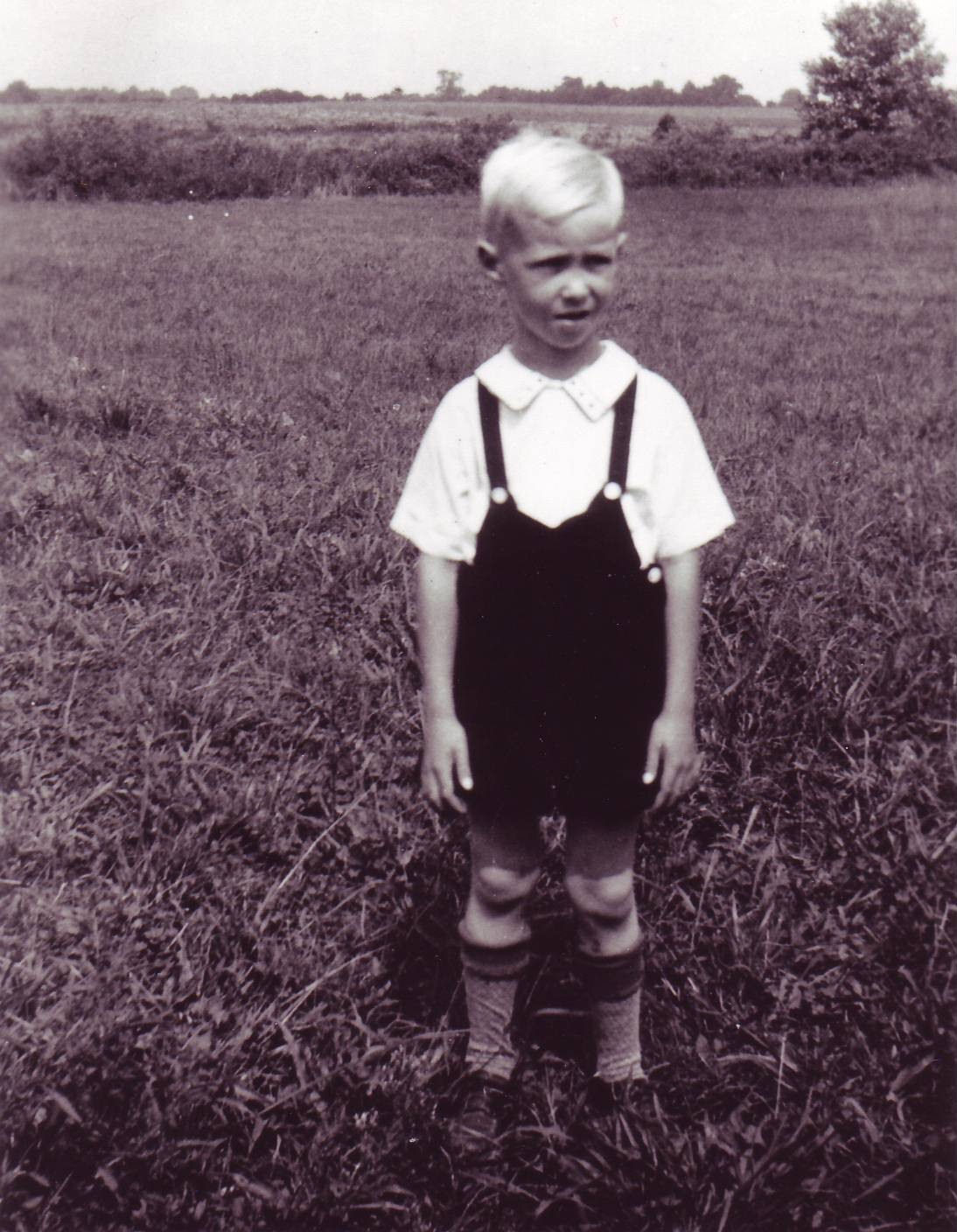
I met Lester Brown in 1956 on board the SS Victoria sailing from Genoa to Bombay. Lester was part of a 4-H agricultural exchange group heading for an internship on Indian soil. My mother, my sister and myself were on our way from Mexico to India to join our Indian father there. As luck would have it, Lester became my square dancing tutor and partner for our amateur entertainment evening. My 14-year old self saw 22-year old Lester as somebody who “would go far.”
I was sad when we parted company in Bombay but very happy many weeks later when Lester showed up at our doorstep in Nagpur. He had been billeted with Jawahar, an Indian farmer who lived not far from our house. Jawahar had taken him to meet my father, an agronomist who had participated in the agrarian reform and green revolution in Mexico during the 1920’s and 30’s. I have since learned that Lester’s sojourn in India was pivotal in shaping his environmental vocation and vision.
As a septuagenarian I am gratified to see that my teenage intuition was spot on: Lester Brown has indeed gone far. He has more than fulfilled the 4-H pledge of clearer thinking, greater loyalty, larger service and better living not only for the benefit of his community but for that of our planet at large.
And there are comments from people who were inspired to publish his books, like Doris and Lars Almstrom of Sweden:
Everybody can contribute to the realization of Plan B. Pick an issue! Take on a leader role! These were the words that rang in our ears and hearts.
Greatly encouraged by the examples of EPI-supporters on the website and in the long lists of thanks in Plan B 2.0, Lars had an idea... and soon we dreamed up a personal plan: to translate Plan B 2.0 into Swedish, our mother-tongue. We'd work on it chapter by chapter, in our spare time, and then make it available for free on a website that we'd manage. … When we started to see the light in the tunnel, Reah Janise wrote in June that in the autumn of 2007 Lester would be out with a new version, Plan B 3.0.
Wouldn't we be keen to translate and publish that one, too? Hm, hm, preferably as a book, and indeed … perfect for university-courses and all...
No small potatoes for the likes of us. Then Lars had an idea again. Let's take early retirement and be free to translate and promote Plan B full-time! We flexed our schedules, took that retirement.
A year later, as in a dream, we took the train out to Arlanda, Stockholm's airport, to welcome Lester, in September 2008. Could it really be us, two quite ordinary people, who had translated the second book, found it a publisher in Stockholm, 700 kilometres from our home-village, arranged a three-day launch far from home with the help of new acquaintances? And who at first hardly could get our tongues to cooperate in expressing ourselves in spoken English! Here we were to meet one of the most influential Americans in history!
But Lester was so friendly, relaxed and experienced, that at the end of his visit we felt we had become great friends. … What an inspiration! …
By now we've also translated and published World on the Edge (as Civilisationens väg) and Full Planet, Empty Plates (as Hungerns planet) and are working on getting Breaking New Ground ready as soon as possible.
Thank you for giving us hope and food for thought to share with your readers and admirers in Sweden.
And from Howard Youth who worked with Lester at Worldwatch Institute:
The man with the silver curls and piercing blue eyes scrutinized me, fingers stroking his slightly downturned chin. The silence weighed heavily upon me. This was my third or fourth interview for this editing job. Winnowed down from more than 100 applicants, I felt proud and excited. But now I was bargaining for my starting salary.
"I'd like that number boosted a bit because I just had an accident and need to buy a new car," I said.
More chin rubbing. And silence. Then speech from the man in the open-collared blue shirt: "Why do you need a car?"
This question shocked me, but would never surprise me again. My Lester-led Worldwatch training had begun. It was not just going to be a job but an outlook-changing experience.
"I live in Rockville and the office is at Dupont Circle," I said, trying not to sound incredulous.
"Why not take the Metro?"
"Well, I will take the Metro, but I still need something to get me around on weekends, during evenings, and so on." Was this thoughtful man trying to de-rail my request for more pay? Or was there more to it?
It turns o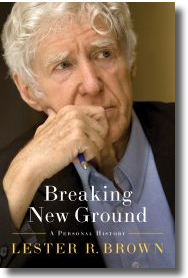 ut there was much more to it. My world view began to expand in that last interview. During my years helping edit and produce World Watch magazine, from the late 1980s to 1992, I would read and edit, edit and read about alternative energy, conservation, food scarcity, climate change, empowerment of women, and new initiatives and inventions that would make our way of life more sustainable. I realized that these ideas in the late 1980s mainly bounced around the corridors of academia and NGOs, but I also knew they were starting to mainstream. I was always impressed by the research team Lester assembled and the diversity of issues we covered in the magazine.
ut there was much more to it. My world view began to expand in that last interview. During my years helping edit and produce World Watch magazine, from the late 1980s to 1992, I would read and edit, edit and read about alternative energy, conservation, food scarcity, climate change, empowerment of women, and new initiatives and inventions that would make our way of life more sustainable. I realized that these ideas in the late 1980s mainly bounced around the corridors of academia and NGOs, but I also knew they were starting to mainstream. I was always impressed by the research team Lester assembled and the diversity of issues we covered in the magazine.
Today, the ideas we presented in World Watch are mainstreamed. And Lester's dogged telling of cautionary tales is part of world dialogues now on auto pilot. When I hear about food scarcity, I often think of Lester. Water scarcity, Sandra Postel. Nuclear issues and alternative energy options, Chris Flavin and Nicholas Lensson. Swords into plough shares, Michael Renner. Women's issues Jodi Jacobson and Mary Gustavson. And so on. Lester's vision extended to other ways to present Worldwatch issues. He hired Jim Gorman to start the magazine, which became another effective tool subscribed to by organizations and libraries the world over.
I left Worldwatch in 1992, moving to India to join my wife on her first overseas tour. … My view of the planet changed since those first interviews with Lester. And the world has changed since then, too. I now see a planet stressed in many ways, yet better in ways thanks to the efforts of Les and other environmental visionaries.
Thanks, Lester! Here's to 80 more years of world vision.
Go to the birthday guestbook to read more of these inspirational comments … and add your own!
Cheers,
Reah Janise Kauffman
Tuesday, February 18, 2014
Our Hungarian translator, David Biro, called the other day to let us know that he was planning on translating some of our Updates, Indicators, and Data Highlights. He had just completed the translation of Breaking New Ground.
David has already translated five of our books, beginning with Plan B 3.0. He’d come across Plan B and thought it warranted publication in Hungarian. Unfortunately we couldn’t pin down a publisher. David was undaunted and simply began translating when he came home from teaching school.
Without any promotional fanfare, we posted his translation of Plan B 3.0 as a PDF. Somehow, news spread. This book and the others he subsequently translated are now regularly downloaded from our website.
In December, for instance, the Hungarian translation of Plan B 3.0 was downloaded 1,102 times, World on the Edge 1,058 times, and Plan B 4.0 1,049 times. David said the books were on reading lists for colleges and universities in his country. By the way, this compares with 3,117 and 1,744 PDF downloads of the English editions of Plan B 4.0 and World on the Edge, respectively, which are also used in U.S. colleges and universities.
This dissemination of our research is one of the things we’d hoped for when we started Earth Policy Institute in 2001. Our mission is to shift the world onto an environmentally sustainable path by cutting carbon emissions, curbing population growth, restoring our natural systems, and shifting to renewable energy. We do this through providing information. Since so many other organizations are well equipped to organize protests, lobby, and defend through the law, we focus on what we believe we can do best: provide integrated analyses of and solutions to the global issues civilization faces.
As a small organization of eight people, disseminating our findings is a huge task. But the Internet makes it infinitely easier for people the world over with access to a computer.
So not only will you find our books available for free downloading on our website, you will find Danish, Finnish, Hungarian, Italian, Polish, Spanish, Swedish, and Vietnamese translations.
Books are not the only publication that generous volunteers translate. Our slide presentations are translated, often by professors who use them in their classes, along with many of our Updates and assorted other research. Just go to a home page for one of our recent books and you'll see!
We are indebted to the volunteer network of people like David, whose expertise provides these translations and allows us to make them available to you.
Cheers,
Reah Janise
P.S. Stay tuned for a future blog on some of our other volunteer translators.
Monday, February 03, 2014
The following is an except from Chapter 2 of Lester Brown's autobiography, Breaking New Ground, Early Years: The Great Depression and World War II.
We were settled away on a good farm and doing well. Then on Sunday, December 7, 1941, the Japanese attacked Pearl Harbor. Suddenly the United States was at war with both Imperial Japan and Nazi Germany. At age thirty-seven, with a family to support and a large farm to operate, Pop was exempt from the draft. But the effects of the war were pervasive. We had air raid drills, where everyone gathered in the school because it was the only large brick building in Stow Creek Township.
As children we looked forward to these drills because once we were assembled we each got a Popsicle, either a chocolate-covered vanilla or an orange-ice-covered one. I usually opted for the latter. At school, we began putting money aside to purchase U.S. savings bonds, a quarter at a time, until we filled seventy-five slots. Costing $18.75, the bonds could be redeemed in twelve years for $25. Metal became scarce and we recycled everything we could find. Gasoline, tires, and sugar were rationed. Farmers were in a favored rationing category, having special access to gasoline and tires, because producing food was such an essential part of the war effort.
Meanwhile I was enjoying school and reading voraciously. Once class assignments were given, I would rush to finish them so I could read books in the library. This was widely recognized by my teachers come report card time. My fourth-grade teacher, Mrs. Tomlinson, wrote, “His reading and choice of reading material, especially historical books, is outstanding. … The thing he needs to do most is to slow up.” The sixth-grade teacher, Mrs. Van Vliet, wrote, “He does his work ‘too fast.’ This leads to carelessness.” This was true, but I was willing to settle for a slightly lower grade because I was learning so much from reading.
During at least one school year, I read over 100 books. I found biographies intensely interesting, including those of our founding fathers. Others I particularly enjoyed were about Abraham Lincoln, Marie Curie, and George Washington Carver. By the time I graduated from eighth grade I had read almost every book in Stow Creek School.
Since we were rather isolated on the farm and since neither of my parents had ever read a book, our dinner table conversations were limited. Biographies opened the world to me in a way that my parents could not. Thus at an early age my sense of self was being influenced by my fascination with these political leaders and scientists. They had addressed the major issues of their time, and I wanted to do the same.
Jim Wood, an older farmer down the road, noticed that whenever we dropped by I would look for their newspapers and then sit quietly reading them while the adults talked. He suggested that each day after school I come by and pick up the two newspapers from the day before—the Philadelphia Inquirer and Bridgeton Evening News. This quickly became part of my daily routine. Since the newspapers were a bit large for me to hold, I spread them out on the living room floor reading them on my hands and knees. Fascinated by the reports on the war, I followed the North Africa campaign with intense interest. The newspapers used maps to show the advances or retreat of the Allied forces. They showed where Rommel’s army was located and described its strategic goals. I learned names of cities like Tripoli, Bizerte, and El Alamein.
Closer to home, one facet of the war was being waged just off the U.S. East Coast. Once at war, we literally had to build thousands of ships, including battleships, destroyers, aircraft carriers, freighters, tankers, and troop transports. Steel for the ships produced at the nearby huge Philadelphia shipyard came from Bethlehem Steel’s Sparrows Point Plant near Baltimore. The steel was shipped down the Chesapeake Bay and the Potomac River, into the Atlantic Ocean, up the East Coast into the Delaware Bay, and up the Delaware River to Philadelphia. Unfortunately the United States had little capacity to deal with the German U-boats. Plying the waters off the U.S. coast, they picked off the U.S. ships one by one as they moved between Baltimore and Philadelphia. Although it was not public knowledge at the time, eighty-six U.S. ships were sunk off the East Coast during 1942, many of them along that stretch of coast between the mouths of the Potomac and Delaware rivers.
The response to these attacks was to avoid going out to the ocean by using the inland canal that connects the upper Chesapeake Bay to the lower Delaware River. Some twenty miles in length, the eastern end of the C & D Canal was only fifteen miles up the river from our farm as the crow flies. Eventually, the U.S. Navy began to thin the ranks of U-boats with much more effective weapons technologies, including destroyers, radar, and depth charges. In 1943, the number of U.S. ships lost off the East Coast dropped to eight.
After nearly two years of the ebb and flow of battle between Allied and Axis forces in North Africa, the Germans and the Italians, who were running out of supplies, were decisively defeated in May 1943. Some 275,000 troops were surrendered to the Allies. Hitler, occupied with mounting problems on the eastern front with Russia, was forced to pull back from North Africa. It was an early turning point in the war.
By this time the air raids on Germany by fleets of U.S. and British bombers, escorted by fighter planes, were rapidly increasing. Then one day the bold headline in the Philadelphia Inquirer said 1,000 Allied planes had crossed the English Channel the previous night. We knew then that the tide was starting to turn.
…
In early 1944, Pop learned of a forty-acre farm for sale in the western end of Stow Creek Township, roughly four miles from where we were living. The owner was asking $2,500. For Pop, the early war period had been years of both good harvests and good prices. He had saved enough money to pay cash for this smaller farm. Mom, however, enjoyed the Dixon farm neighborhood and friends there, and she was reluctant to move. It was one of the few times she demurred when Pop made a decision. The bottom line was we’d have not only a farm but also a home of our own. The soils, though not as uniformly fertile as those on the Dixon farm, were nonetheless quite productive.
This farm, which had electricity but no indoor plumbing, came with seven acres of asparagus. The asparagus beds, which can produce for up to twenty years once established, were aging. But for the first few years on the farm, we cut asparagus beginning in mid-April and continuing through the end of June. The asparagus went to the P.J. Ritter cannery in Bridgeton, New Jersey, roughly ten miles from the farm, for 9¢ a pound. Cutting asparagus is hard, backbreaking work, but there was a good market. We also grew peppers and tomatoes. This farm on Sandwash Road was to become the family homestead, the Brown farm, where our parents spent the rest of their lives. And it was here that our little sister, Marion, was born in 1945. There were nearly three years between me and Carl, and nine years between him and Marion. The farm is still in the family, now owned by my brother and me.
During the summer of 1944, when I was ten, we took our tomatoes to the same P.J. Ritter cannery that processed our asparagus. Much to my astonishment, when we started handing the baskets of tomatoes from the truck to the factory hands, I realized we were handing them to German prisoners of war. They all wore khaki jumpsuits with “PW” hand-stenciled on the back in large, black letters. They were among the troops who had surrendered to Allied forces in North Africa. When given a choice of staying in detention camps in the desert or coming to the United States to work, they chose the latter. With some 600 German soldiers living in our community, the war that I was following so intently in the newspapers suddenly felt very close.
Then in 1945 the war came to an end and the country gradually worked itself back to a more normal existence.
To read more of Lester Brown's life, purchase a copy today for our special sale price of $15.00.
Best,
Reah Janise Kauffman
Tuesday, January 14, 2014
This excerpt is from Chapter 7, Shifting Gears: The Overseas Development Council, from Lester Brown's autobiography, Breaking New Ground.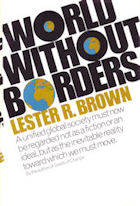
My next book, World Without Borders, was for me a breakout work both in the breadth of issues it covered and the audience it was reaching. It described how the world was tied together by the earth’s natural systems, the fast-growing trade and financial links, and their interplay with governments. The bottom line was that the world needed new and stronger international institutions to deal with these linkages. Fortuitously, the international community, led by the United States, created the United Nations Population Fund in 1967 (originally called the United Nations Fund for Population Activities, UNFPA) and, in 1972, the United Nations Environment Programme.
The New Yorker described World Without Borders as “an encyclopedic, lucid assessment of some of the world’s persistent problems … and some carefully documented, highly plausible suggestions for solving them. [Brown] persuasively argues … that the day of the militaristic nation state is over, and that a unified global society is the only hope for survival.” This book was about globalization well before the concept was widely used.
At this point, with time to broaden my knowledge of the world, I was becoming keenly aware of the expanding role of multinational corporations in the global economy. This was a time not only of world economic growth but of economic integration across national boundaries. Corporations would produce for a world market. Manufacturing supply chains could be anchored in many countries.
To illustrate this point, I constructed an integrated list of countries (measured by gross national product) and corporations (measured by gross annual sales). In the top fifty of this integrated list of 100, countries dominated, with only eight corporations making the top fifty. General Motors, the largest corporation, was ranked eighteenth. In the second grouping of fifty, there were thirty-six corporations and only fourteen countries. We clearly had entered a new era, one of not only increased corporate influence but also of globalization. We clearly had entered a new era of increased corporate influence and of globalization.
The title for the book came from a newspaper article in which students in Prague, Czechoslovakia, were interviewed some time after Soviet tanks had rolled into their city to quell the 1968 uprising. When a student was asked what kind of world she would like, she responded, “A world without borders.” The words jumped off the page, capturing the spirit of the book that I was writing.
For more on World Without Borders, see our earlier blog, which includes a nine-minute interview with Lester about the book's findings.
For more on Lester’s life check out the photo albums on our website and pick up a copy of Breaking New Ground today!


